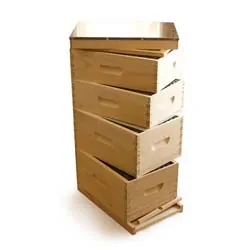Now that you’ve learned more about “When to Feed” and “What to Feed” your honeybees through our other PerfectBee Snippets, it’s time to prepare to complete the task of feeding your bees.
Tips For Feeding
Here are some helpful tips for adding feeders and supplemental feed sources to your beehive:
- Provide feed in the late afternoon or evening to prevent robbing as scouts from other colonies are less active in searching for food sources during these times.
- Avoid syrup spills whenever possible, this can attract other pests and cause possible robbing.
- Feed small quantities of pollen or winter patties to prevent spoilage of the feed and the introduction of pests, like small hive beetles.
- A good practice is to feed internally to prevent robbing. Avoid open-source feeding and entrance feeders that sit outside of the hives, especially during the dearth as they attract robbing and pests and can spread diseases.
- Ensure all feeders and equipment used are clean.
- If feeding in the fall, feed early enough in the season that the bees have enough time to evaporate excess moisture before temperatures drop.
- Observe and pay close attention to the amounts of royal jelly in the brood cells with young larvae to assess the proper diet for the brood. Royal jelly is a shiny white substance that should be abundant in brood cells, smaller larvae should be “swimming in” it.
- Be careful not to leave any feeding debris like packaging, foil, buckets or feeders around your bee yard or you’ll attract pests.
Feeders and Equipment by Feed Type
The feeder you use to feed your bees will likely depend on the type of feed you’re using. There are many different types of feeders available. See the full lineup of feeders available in the PerfectBee Store here with options to either go inside your hive, on top of your hive, or out at the entrance. Read on to find further links about feeders in our “learn more” section below.
Feeders for Sugar Syrup:
- In the fall, rapid feeders (like hive top feeders) can provide large quantities of the heavy 2:1 sugar syrup with low water content for bees to use as winter storage.
- In the spring, dripping feeders such as a simple mason jar with holes poked in the lid (or our Ultimate Direct Feeder) work best to dispense thin 1:1 sugar syrup. The slower, stimulating method of accessing the feed is better to help stimulate your queen to lay eggs, help workers build wax, and prevent a rapid accumulation of feed in the comb.
Feeding dry sugar is done supplementally on top of an inner cover or directly on top of frames over newspaper in an emergency feeding situation. See the PerfectBee Snippet “What to Feed” for more information on feeding dry sugar.
Fondant or sugar cakes are typically fed in the deeper side of a deep rim inner cover or placed directly on top of frames during wintertime.
Pollen patties are often flattened and placed in small pieces directly over the brood nest, either on top of frames or inside of a deep rim inner cover (linked above).
Winter patties are flattened and laid on top of frames directly above the cluster’s location within a hive.
Dry pollen substitute or ground pollen granules are a great way to offer pollen during a dearth. Feeding dry pollen instead of patties can help to reduce robbing, especially in the fall months. The ground mixture can be placed inside a container or in a covered bird feeder as long as it’s kept dry. Bees need space within the container to be able to roll the pollen into their baskets and then fly back to the hives. The pollen feeder should be positioned in close proximity to the hive, but not less than 50 feet so that bees can communicate its location via dance. Learn more about feeding dry pollen here.
Learn More
- An Introduction To Feeding Bees
- What Bees Need
- How Far Do Bees Forage?
- Perspective on Feeding Bees
- The Beekeeper’s Role in Avoiding Colony Starvation
- Winter or Pollen Patties
- Open Or Closed Feeding: Which Is Best?
Colony Member Resources
- Warm weather notes and caution
- Feeding bees honey
- Feeding sugar board
- What to feed bees in the fall
- Ultra Bee Protein Pollen Patties
- Sugar boards for overwintering bees
- Spring Feeding Time
Are you not yet a Colony member but want to join discussions like these with other beekeepers? Do you have an interest in learning more about beekeeping through our members-only Academy lessons? See all the benefits that come with Colony membership here.
